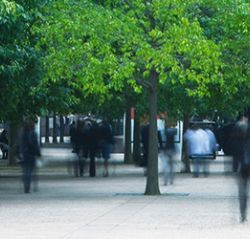Reflections on albedo: Why it matters
Tom Vandyck |

To stabilize our climate, we need to preserve the Earth’s albedo – its overall heat reflectivity. Here’s how that works:
Every moment of every day, 173,000 terawatts of energy reach Earth from the sun. That’s about 10,000 times more than humanity’s total energy use. But not all that energy stays on Earth. About a third (31 percent) is reflected into space immediately.
The Earth’s reflectivity is also known as its albedo; and it plays an important role in regulating our climate.
To keep the planet cool, make it lighter
Every surface has its own albedo value. The lighter-colored a surface is, the more heat it reflects and the higher its albedo.
High-albedo surfaces:
- Snow and ice: Reflect up to 90% of sunlight
- Clouds: Reflect 30-80% of solar energy
- Deserts: Light-colored sands have moderate albedo
Low-albedo surfaces:
- Forests: Dark green absorbs sunlight, with an albedo of 10-20%
- Oceans: Deep blue absorbs even more sunlight, reflecting only about 6-10%
- Cities: Asphalt and concrete trap almost all heat – their albedo is as low as 5%
It’s a people problem
When it comes to climate, the basic rule is simple:
the more dark surfaces, the more heat the planet retains. Things get more complicated when you mix in the human factor.
- As we emit carbon dioxide and other climate change drivers including methane, black carbon and HFCs, we cause global warming.
- More heat in the atmosphere causes more ice and snow to melt, which exposes more low-albedo surfaces such as rock, soil, and seawater.
- These darker surfaces absorb heat, causing more snow and ice to melt. This causes a feedback loop of rising heat, melting and more heat.
Other human drivers of albedo changes include:
- Deforestation: Cutting down forests lowers albedo.
- Urbanization: Asphalt, concrete and other dark materials used in the built environment absorb more heat, leading to the so-called urban heat island effect.
- Pollution: Soot and dust darken surfaces and can cause snow and ice to melt.
So, what can we do?
Preserving and even taking steps to increase the planet’s albedo are an important component of the fight against climate change. These steps can help:
Lowering emissions
The sooner we reduce excess atmospheric heat, the more ice and snow we’ll stop from melting.
Protecting ice and snow
Other steps to preserve our most reflective surfaces include limiting the use of ice breakers and lowering air pollution to eliminate heat-absorbing dark deposits.
Preserving ecosystem
We’ve already seen that replacing deserts with darker farms, roads, industry, and residential buildings lowers the Earth’s albedo. But did you know that higher ocean temperatures lead to the loss of phytoplankton, whose metabolic gases promote the formation of clouds? Maintaining these ecosystems helps preserve the Earth’s albedo.
Increasing Earth’s reflectivity
The use of lighter-colored and reflective construction materials helps counteract the urban heat island effect and contributes modestly to albedo protection. Trees and plants reflect more heat than asphalt and create shade that protects people from heat.








